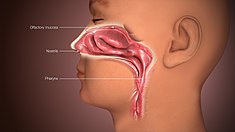Nose
| Nose | |
|---|---|
 Nose of a dog | |
| Details | |
| Identifiers | |
| Latin | nasus |
| MeSH | D009666 |
| TA98 | A06.1.01.001 A01.1.00.009 |
| TA2 | 117 |
| Anatomical terminology | |
A nose is a protuberance in
Air treatment

Acting as the first interface between the external environment and an animal's delicate internal lungs, a nose conditions incoming air, both as a function of thermal regulation and filtration during respiration, as well as enabling the sensory perception of smell.[6]
Hair inside nostrils filter incoming air, as a first line of defense against dust particles, smoke, and other potential obstructions that would otherwise inhibit respiration, and as a kind of filter against airborne illness. In addition to acting as a filter, mucus produced within the nose supplements the body's effort to maintain temperature, as well as contributes moisture to integral components of the respiratory system. Capillary structures of the nose warm and humidify air entering the body; later, this role in retaining moisture enables conditions for alveoli to properly exchange O2 for CO2 (i.e., respiration) within the lungs. During exhalation, the capillaries then aid recovery of some moisture, mostly as a function of thermal regulation, again.[7]
Sense of direction
The wet nose of dogs is useful for the perception of direction. The sensitive cold receptors in the skin detect the place where the nose is cooled the most and this is the direction a particular smell that the animal just picked up comes from.[8]
Structure in air-breathing forms

In amphibians and lungfish, the nostrils open into small sacs that, in turn, open into the forward roof of the mouth through the choanae. These sacs contain a small amount of olfactory epithelium, which, in the case of caecilians, also lines a number of neighbouring tentacles. Despite the general similarity in structure to those of amphibians, the nostrils of lungfish are not used in respiration, since these animals breathe through their mouths. Amphibians also have a vomeronasal organ, lined by olfactory epithelium, but, unlike those of amniotes, this is generally a simple sac that, except in salamanders, has little connection with the rest of the nasal system.[9]
In
The nasal cavities in mammals are both fused into one. Among most species they are exceptionally large, typically occupying up to half the length of the skull. In some groups, however, including
In
The vomeronasal organ of mammals is generally similar to that of reptiles. In most species, it is located in the floor of the nasal cavity, and opens into the mouth via two nasopalatine ducts running through the palate, but it opens directly into the nose in many rodents. It is, however, lost in bats, and in many primates, including humans.[9]
In fish
Fish have a relatively good sense of smell.
The pouches are lined by olfactory epithelium, and commonly include a series of internal folds to increase the surface area, often forming an elaborate "olfactory rosette". In some teleosts, the pouches branch off into additional sinus-like cavities, while in coelacanths, they form a series of tubes.[9]
In the earliest vertebrates, there was only one nostril and olfactory pouch, and the nasal passage was connected to the hypophysis. The same anatomy is observed in the most primitive living vertebrates, the lampreys and hagfish. In gnathostome ancestors, the olfactory apparatus gradually became paired (presumably to allow sense of direction of smells), and freeing the midline from the nasal passage allowed evolution of jaws.[11]
See also
- Nasal bridge
- Obligate nasal breathing
- haplorrhineprimates such as humans
References
- ^ "7.2 the Skull". Anatomy and Physiology - The Skull. OpenStax. 2020-04-05.
- ^ "22.1 Organs and Structures of the Respiratory System". Anatomy and Physiology - Organs and Structures of the Respiratory System. OpenStax. 2020-04-05.
- ISBN 9781935567202.
- S2CID 240228857.
- ^ "Mammals' noses come from reptiles' jaws: Evolutionary development of facial bones". Phys.org. November 1, 2021.
- ^ "Your Nose, the Guardian of Your Lungs". Boston Medical Center. Retrieved 2020-06-29.
- ^ "22.1 Organs and Structures of the Respiratory System". Anatomy and Physiology - Organs and Structures of the Respiratory System. OpenStax. 2020-04-05.
- ISBN 90-313-0322-4 [page needed]
- ^ ISBN 0-03-910284-X.
- ^ "Will Fish Lose Their Sense of Smell in Acidic Oceans?". 2018-08-07.
- S2CID 205232053.
